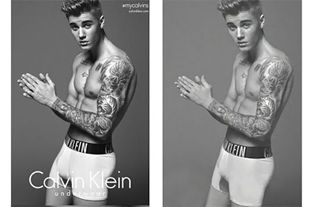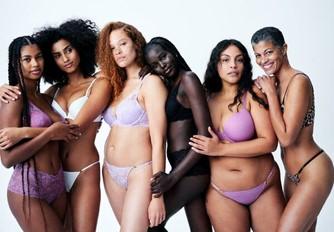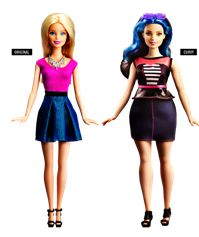Body Image – Traditional Media
Music
 Music is a significant medium in a young person’s life, particularly during the teenage years. While other media may occupy a greater number of hours, it is most often from music that teenagers define their identities and draw cues about how to dress and to behave.
Music is a significant medium in a young person’s life, particularly during the teenage years. While other media may occupy a greater number of hours, it is most often from music that teenagers define their identities and draw cues about how to dress and to behave.
For example, one study found that just ten minutes’ exposure to music videos featuring thin, sexualized performers led to a measurable increase in body dissatisfaction.[2]
So how do music videos, as well as other images associated with music, influence youth? For girls, the message is overwhelmingly that they should be thin, attractive and sexual.[3] What’s more, this message doesn’t vary between different genres of music,[4] as nearly all performers must meet this standard to be commercially successful (or else have their images electronically manipulated to meet that standard). Lyrics, as well, can promote negative body image if they focus on physical appearance.[5]
When female musicians gain weight, it is often covered in a negative light. Performers such as Kelly Clarkson, Rihanna and Lady Gaga have received criticism both in the press and in social media after gaining weight.[6] Female performers who aren’t sexualized at the beginning of their careers, particularly those who become successful as teenagers, are frequently under pressure to adopt a more sexual persona as they transition to an adult career.[7] When this happens, discussion of the performer often moves from her music to her sexuality, leading to a much greater emphasis on body size and other physical attributes both in how she is presented in videos and in media coverage.[8]
 Though boys receive different messaging, music is similarly influential. Perhaps due to the heavily ripped physiques now standard among male hip-hop, heavy metal and even country singers, teenage boys who watch music videos are at higher risk of becoming obsessed with bodybuilding. [9]
Though boys receive different messaging, music is similarly influential. Perhaps due to the heavily ripped physiques now standard among male hip-hop, heavy metal and even country singers, teenage boys who watch music videos are at higher risk of becoming obsessed with bodybuilding. [9]
There are exceptions, of course. Many genres of music present both male and female performers with much less emphasis on their appearance, with artists such as Queen Latifah, Macy Gray and Lizzo defying body image norms.
Film and TV
People with larger bodies, especially girls and women, are both under-represented and stereotyped in film and television. A 2022 study found that just 6.7 percent of characters in the decade’s most popular films had larger bodies and that many of those fell into the “funny friend” role.[10]
An example of this is the TV series Friends, one of the most successful series of the 1990s and still one of the most lucrative streaming shows. Researchers found that watching a ten-minute segment of the show had a negative effect on how satisfied young women were with their appearance.[11] Since the segment shown didn’t have any content directly related to weight or body image, it seems likely that viewing similar shows would have a similar effect.
When women of above average weight do appear, they tend to draw negative comments from other characters about their looks. These comments are almost always followed by “canned” laughter, indicating that the audience is expected to agree that these characters are appropriate butts of humour.[12] On Friends, for example, the character of Monica is shown as having a larger body in flashbacks – portrayed by the same actress, wearing a “fat suit” – in which her weight is consistently played for laughs. There are some signs that this is beginning to change, though, with movies such as Booksmart and series such as Survival of the Thickest casting larger-bodied women in roles that give them the leading and romantic roles usually reserved for thin women. Still, “complex and non-stereotyped fat characters are still few and far between, especially in science fiction and other genre entertainment,”[13] and studies of more recent TV series have found that while they “were less explicit in ostracizing their overweight characters than those in prior decades, they continued to propagate negative stereotypes.”[14]
While White actors are now rarely cast to play non-White characters in film or television, it remains common for larger-bodied characters to be played by thin actors wearing fat suits. Two recent major films, Dune and The Whale (for which lead actor Brandon Fraser received an Academy Award) featured characters in fat suits. According to comedian Guy Branum, “the fat suit is such a fascinating way of saying that this character is not human. It is hard to be simultaneously told, ‘There are no parts that are right for you in Hollywood,’ and then have somebody put on a costume to look like me.”[15]
Advertising and magazines
Advertising, particularly for fashion and cosmetics, has a powerful effect on how we see ourselves and how we think we should look. They also have a large influence on body image and dissatisfaction: 50 percent of ads found in teen magazines use “sexualized beauty” to sell products, creating a mindset from a young age that beauty is defined by looking and acting a certain way.[16]
 In addition to content, images of women’s – and, increasingly, men’s – bodies themselves also send messages. The average American woman, for example, wears a size 14, while the Association of Model Agents recommends that professional models be no larger than a size two.[17]
In addition to content, images of women’s – and, increasingly, men’s – bodies themselves also send messages. The average American woman, for example, wears a size 14, while the Association of Model Agents recommends that professional models be no larger than a size two.[17]
Even these underweight models are often not considered thin enough by editors, who use Photoshop and other image manipulation tools to create women who are literally “too thin to be true” – as well as to alter photos of celebrities so they meet this standard. Men’s images in magazines are also frequently photomanipulated to achieve the lean and muscular ideal.[18]
Why is there such pressure to make models increasingly thinner, to the point of erasing whole body parts?[19] Simply put, advertisers believe that thin models sell products. For almost a century, advertisers have appealed to – or contributed to – women’s insecurities in hopes of selling them the solution.[20] In fact, advertising is so strongly associated with creating insecurities that when women are shown images of products like shoes, perfume or deodorant in the context of fictional ads, they’re more likely to answer negatively to questions such as “How attractive do you find yourself?” or “How satisfied are you with your body?” than if they saw the same photos in a neutral context.[21]
While it’s well-established that seeing images of underweight women make normal or larger-bodied women feel bad about themselves,[22] some recent research has found that that the conventional wisdom in the fashion and advertising worlds is wrong, and that consumers are less interested in buying products that make them feel insecure. (The same research, though, found that exposure to larger-bodied models had a similar negative effect on women’s self-esteem.)[23]

In recent years there have been some efforts in the industry to buck the trend. Some clothing retailers have committed to not using underweight models. In 2014, Aerie pledged not to retouch any of the images used in their apparel advertisements as a part of their #AerieREAL campaign. [24] This successful approach has been copied by industry giant Victoria’s Secret, which has run ads including women with a variety of body shapes, and celebrities such as Kim Kardashian and Rihanna have launched underwear lines that include a broader range of body shapes.[25]
There is resistance to change, both within and outside the industry. When the Australian magazine New Woman included a picture of a heavy-set model on its cover, it received a truckload of letters from grateful readers praising the move, but its advertisers complained and the magazine returned to featuring bone-thin models.[26] According to Kirstie Clements, the former editor of Australian Vogue, this response is not unusual: “[editors] get so caught up in the hype of how brilliant clothes look on a size 4, they cannot see the inherent danger in the message…Many high fashion labels are aghast at the idea of producing a size 14, and they certainly wouldn’t want to see it displayed in the pages of the glossies.”[27] Frequently, even if brands include larger-bodied models in their ads, they do not want them as customers – as when Everlane “launched a new underwear line featuring a plus-size model in its ad campaign, despite making no actual plus-size underwear for sale.”[28]
Toys
There are few media to which youth are exposed to as early as toys, which make up an important part of their media consumption throughout childhood. Despite competition from electronics, the Canadian toy industry saw an increase in sales of 6.5 percent in the start of 2020 compared to the same time in the previous year.[29] As a result, the messages about body image that children get from toys that they’re buying or being given may come at a time when they are still forming ideas about gender identity.
 Perhaps the most famous example of a media product that creates a distorted body image in women is the Barbie doll. One of the best-selling toys of all time, according to Barbiemedia.com “more than 100 dolls are sold every minute, with a total of 58 million sold annually.”[30] Barbie, created in 1959, has measurements that, at 1/6 scale, would make her 5’9” tall, with a 36-inch bust and an 18-inch waist.[31] It comes as no surprise, then, that girls exposed to Barbie were more likely to prefer thin bodies.[32] In 2016 Mattel released Barbie dolls with three new body types, curvy, petite and tall; when testing the new dolls, however, Mattel discovered that young girls would “undress the [new curvy doll] and snicker a bit,” suggesting that “even kids as young as 6 or 7 are already conditioned for a perfect silhouette in their dolls”[33] – which may be why of the 96 dolls featured on the first page of the Barbie website, only five have the “curvy” body shape.
Perhaps the most famous example of a media product that creates a distorted body image in women is the Barbie doll. One of the best-selling toys of all time, according to Barbiemedia.com “more than 100 dolls are sold every minute, with a total of 58 million sold annually.”[30] Barbie, created in 1959, has measurements that, at 1/6 scale, would make her 5’9” tall, with a 36-inch bust and an 18-inch waist.[31] It comes as no surprise, then, that girls exposed to Barbie were more likely to prefer thin bodies.[32] In 2016 Mattel released Barbie dolls with three new body types, curvy, petite and tall; when testing the new dolls, however, Mattel discovered that young girls would “undress the [new curvy doll] and snicker a bit,” suggesting that “even kids as young as 6 or 7 are already conditioned for a perfect silhouette in their dolls”[33] – which may be why of the 96 dolls featured on the first page of the Barbie website, only five have the “curvy” body shape.

Unlike Barbie and similar girls’ dolls, whose bodies have been fairly consistent over time, equivalent toys for boys – termed “action figures” due to a belief that boys would not want to play with dolls – have gone from realistic to grossly exaggerated. The first G.I. Joe figure, introduced in 1964, had a waist that would translate to 32-inches at human scale, along with 12-inch biceps. By 1991 the figure’s waist had shrunk by three inches while the biceps had gained four; 1995’s “GI Joe Extreme” figure would have biceps nearly 27 inches around – larger than any bodybuilder ever known.[34] Some recent action figures have muscles bigger than their heads, which immediately associates masculinity with violence and aggression in the argument for brain vs. brawn.[35] The same pattern is found in figures which represent film characters. The 1978 “Star Wars” figures representing Han Solo and Luke Skywalker have proportions similar to the actors that play them, Harrison Ford and Mark Hammill; the 1998 figures, however, much more closely resemble Arnold Schwarzenegger and other bodybuilders-turned-actors.[36] Recent figures with similar proportions are often based on popular video games, such as those based on the God of War and World of Warcraft series and cartoons such as the rebooted Masters of the Universe series.
If you or someone you know needs support in dealing with an eating disorder, visit the National Eating Disorder Information Centre.
[1] McClure, K. J., Puhl, R. M., & Heuer, C. A. (2011). Obesity in the news: do photographic images of obese persons influence antifat attitudes?. Journal of health communication, 16(4), 359-371.
[2] Beth T. Bell, Rebecca Lawton, Helga Dittmar, “The impact of thin models in music videos on adolescent girls’ body dissatisfaction,” Body Image, 4:2, June 2007, 137-145.
[3] Report of the APA Task Force on the Sexualization of Adolescent Girls. American Psychiatric Assocation, 2010.
[4] Ibid.
[5] Coyne, S. M., Davis, E. J., Warburton, W., Stockdale, L., Abba, I., & Busby, D. M. (2021). Mirror, mirror on the wall: The effect of listening to body positive music on implicit and explicit body esteem. Psychology of Popular Media, 10(1), 2.
[6] La Jeunesse, Marilyn. “17 Celebrities Who Were Body-Shamed and Spoke Out Against It.” Allure, December 12 2018. <https://www.allure.com/gallery/celebrities-body-shamed>
[7] Andsager, J. L., & Roe, K. (1999). Country music video in country’s year of the woman. Journal of Communication, 49, 69-82.
[8] Ibid.
[9] Marika Tiggemann (2005). Television and Adolescent Body Image: The Role of Program Content and Viewing Motivation. Journal of Social and Clinical Psychology, 24:3, 361-381.
[10] (2022) #AllBodies Report: Representations of Fat Women and Girls in Hollywood. The Rep Project. https://therepproject.org/wp-content/uploads/2022/07/2022AllBodies_FatWomenInHollywood_Report_V2_TypoFixed.pdf
[11] Want, S.C., Vickers, K. & Amos, J. (2009). The influence of television programs on appearance satisfaction: Making and mitigating social comparisons to “Friends”. Sex Roles,60, 642-655.
[12] Fouts, G., & Vaughan, K. (2002). Television situation comedies: Male weight, negative references, and audience reactions. Sex Roles, 46(11/12), 439-442.
[13] Stark, Sarah. (2022) “It’s time to abolish the fat villain trope.” Inverse. https://www.inverse.com/entertainment/abolish-the-fat-villain-trope
[14] Hudson, R. (2023). “There is nothing more powerful than a fat girl who doesn't give a f---k”: Gender and Body Size in Euphoria, The Wilds, and Glee Rose Hudson V00795638 An Essay Submitted in Partial Fulfillment of the Requirement for the Degree of (Doctoral dissertation, University of Victoria).
[15] Quoted in Stark, Sarah. (2022) “It’s time to abolish the fat villain trope.” Inverse. https://www.inverse.com/entertainment/abolish-the-fat-villain-trope
[16] Wang, K (2017). The impact of advertisements: How female readers in China perceive fashion magazine advertisements and white ski. Kansas State University. p.11)
[17] Jones B. (2017) Model Diversity in Fashion Advertising: The Influence of Self-Model Congruity on Body Appreciation. University of Minnesota.
[18] “The Complicated Art of Airbrushing Abdominals.” Jezebel, October 7, 2010. <http://jezebel.com/5658169/the-complicated-art-of-creating-abdominals?tag=photoshopofhorrors>
[19] “May Vogue Visits The Future And The Future Is Missing A Clavicle.” Jezebel, May 6, 2008. <https://web.archive.org/web/20180712215410/https://jezebel.com/387701/may-vogue-visits-the-future-and-the-future-is-missing-a-clavicle>
[20] Copeland, Libby. “How advertisers create body anxieties women didn’t know they had and then sell them the solution.” Slate, April 14, 2011.
[21] “The Self-Activation Effect of Advertisements: Ads Can Affect Whether and How Consumers Think About the Self,” by Debra Trampe, Diederik A. Stapel and Frans W. Siero, The Journal of Consumer Research.
[22] Dirk Smeesters, Thomas Mussweiler, and Naomi Mandel. “The Effects of Thin and Heavy Media Images on Overweight and Underweight Consumers: Social Comparison Processes and Behavioral Implications.” Journal of Consumer Research: April 2010.
[23] “Real curves on models don’t always appeal.” March 17, 2010.
[24] Schlossberg, M (2016) These unretouched photos show why a teen retailer is giving Victoria’s Secret a run for its money. Business Insider. Retrieved from https://www.businessinsider.com/aerie-ad-photos-are-not-airbrushed-2015-7
[25] Friedman, V. (2022) “Victoria’s Secret and What’s Sexy Now.” The New York Times. https://www.nytimes.com/2022/07/13/style/victorias-secret-rebrand.html
[26] Peter Walker. “Young, white and super skinny? We don’t buy it, women tell advertisers.” The Guardian, January 10, 2010.
[27] Clements, K (2013). Former Vogue Editor: The truth about Size Zero. The Guardian. Retrieved from https://www.theguardian.com/fashion/2013/jul/05/vogue-truth-size-zero-kirstie-clements
[28] Mull, A. (2018) “Body Positivity Is a Scam.” Vox. https://www.vox.com/2018/6/5/17236212/body-positivity-scam-dove-campaign-ads
[29] NPD group (2020) Canadian Toy sales show strong growth through Covid 19 lockdown. Retrieved from https://web.archive.org/web/20210120090339/https://www.npdgroup.ca/wps/portal/npd/ca/news/press-releases/canadian-toy-sales-show-strong-growth-through-covid-19-lockdown/
[30] Mattel (2016). Barbie Fast Facts. Retrieved from http://www.barbiemedia.com/about-barbie/fast-facts.html
[31] “Barbie (Doll)”. The New York Times. Retrieved November 23, 2011. http://topics.nytimes.com/topics/reference/timestopics/subjects/b/barbie_doll/index.html
[32] Rice, K., Prichard, I., Tiggemann, M., & Slater, A. (2016). Exposure to Barbie: Effects on thin-ideal internalisation, body esteem, and body dissatisfaction among young girls. Body Image, 19, 142-149.
[33] Dockterman, E (2016) Barbie’s got a new body. Time. Retrieved from https://time.com/barbie-new-body-cover-story/
[34] Pope, Harrison G. Jr., et al. Evolving Ideals of Male Body Image as Seen Through Action Toys. International Journal of Eating Disorders 26: 65-72, 1999.
[35] Bradley University (n.d.) G.I. Joe and Barbie. Retrieved from https://www.bradley.edu/sites/bodyproject/media/gi-barbie/
[36] Bradley University (n.d.) G.I. Joe and Barbie. Retrieved from https://www.bradley.edu/sites/bodyproject/media/gi-barbie/
